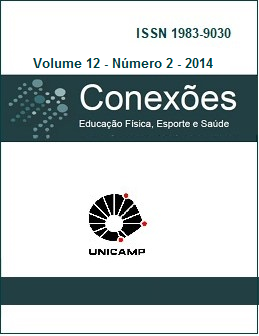Abstract
Analysis of body composition of professionals based on chronological age and years of
training, soccer is important in the evaluation, diagnosis, prescription and monitoring of
training, allowing you to make proper planning of the conditions physical, and consequently
achieve specific adaptations to improve athletic performance. Objective: To analyze the body
composition of professional footballers based on chronological age and years of training.
Methods: The sample consisted of 95 professional players from League Perú. Chronological
age, years of training, weight, height, 6 skinfolds , % fat, fat mass (MG) and fat-free mass
(FFM) was assessed. Age and years of training were classified into 5 ranks. Descriptive
statistics were performed and two-way ANOVA and Tukey were applied, with a significance
level of 5%. Results: There was significant increase in body weight (5.4 kg) and FFM (4.7 kg)
as a function of chronological age. As the years of training the increased weight (4.41kg) and
MLG (3.99 kg). Significant increases in body weight and MLG are reached in the age range of
26-29 years of age and averaged 12.6 ± 2.2 years of training. Conclusions: Total body mass
and FFM increase with chronological age and years of training. These results suggest
classifying players by age and years of training with the intention of assessing and designing
specific training programs.
References
FUKE, K.; PUPO, J.; CORRÊA, S. Evaluación de la composición corporal y de la flexibilidad en futbolistas profesionales en diferentes etapas del ciclo de entrenamiento. Archivos de Medicina del Deporte, Espanha, v. 26, n. 129, p. 7-13, 2009.
HEYWARD, V. H. Advanced fitness assessment and exercise prescription. Champaign: Human Kinetics Books, 1991.
SILVESTRE, R. et al. Body composition and physical performance during a National Collegiate Athletic Association Division I men's soccer season. Journal of Strength Conditioning Research, v. 20, n. 4, p. 962-970, 2006.
SUTTON, L. et al. Body composition of English Premier League soccer players: influence of playing position, international status, and ethnicity. Journal of Sports Sciences, v. 27, n. 10, p. 1019-1026, 2009.
HAZIR, T. Physical characteristics and somatotype of soccer players according to playing level and position. Journal of Human Kinetics, Champaign, v. 26, p. 83-95, 2010.
COSSIO-BOLANOS, M. A. et al. Body size and composition of the elite peruvian soccer player. JEPonline, v. 15, n. 3, p. 30-38, 2012.
GÓMEZ, J. R. et al. Modificaciones morfofuncionales con un sistema de entrenamiento ATR en un equipo de fútbol profesional. Apunts Medicina de L’Esport, Barcelona, v. 147, p. 11-22, 2005.
KRAEMER, W. J. et al. Body size and composition of National Football League players. Journal of Strenght Conditioning Research, Colorado Springs, v. 19, n. 3, p. 485-489, 2005.
GUR, H. et al. Effects of age on the reciprocal peak torque ratios during knee muscle contractions in elite soccer players. Scandinavian Journal of Medicine and Science in Sports, Oxford, v. 9, p. 81-87,1999.
KRAEMER, W. J. et.al. Changes in exercise performance and hormonal concentrations over a Big Ten soccer season in starters and nonstarters. Journal of Strength Conditioning Research, Colorado Springs, v.18, p. 121-128, 2004.
MATKOVIC, B. R. et.al. Morphological differences of elite croatian soccer players according to the team position. Coll Antropology, v. 27, p. 167-174, 2003.
SPORIS, G. et al. Fitness profiling in soccer: physical and physiologic characteristics of elite players. Journal of Strength Conditioning Research, Colorado Springs, v. 23, n. 7, p. 1947– 19953, 2009.
OBERG, B. et al. Muscle strength and flexibility in different positions of soccer players. International Journal of Sports Medicine, Sttugart, v. 5, p. 213-216, 1984.
ROSS, W. D.; MARFELL-JONES, M. J. Kinanthropometry. In: MACDOUGALL, J. D.; WENGER, H. A.; GEEN, H. J. Physiological testing of elite athlete. Champaign: Human Kinetics, 1991. p. 223-308.
COSSIO-BOLAÑOS, M. A.; ARRUDA, M.; LANCHO, J. L. Concordancia del porcentaje graso a través de métodos antropométricos en futbolistas profesionales. Kronos, v. 10, n. 2, p. 48-54, 2011.
REILLY, T.; BANGSBO, T.; FRANKS, A. Anthropometric and physiological predispositions for elite soccer. Journal of Sports Sciences, London, v. 18, p. 669-683, 2000.
REILLY, T.; KEANE, S. Seasonal variations in the fitness of elite Gaelic footballers. Journal of Sports Sciences, London, v. 17, p. 818-9, 1999.
AMATO, M. et al. Influence of age and physical activity on isokinetic characteristics of hamstrings and quadriceps muscles of young gymnasts and soccer players. Annales de Réadaptation et Médicine Physique, v. 44, n. 9, p. 581-590, 2001.
FOUSEKIS, K.; TSEPIS, E.; VAGENAS, G. Knee and ankle isokinetic strength asymmetries in professional soccer players with right footedness. Journal of Sports Science Medicine, v. 8, supl. 8, p. 200, 2009.
RODRÍGUEZ-GUTIÉRREZ, C.; ECHEGOYEN, S. Características antropométricas y fisiológicas de jugadores de fútbol de la selección mexicana. Archivos de Medicina del Deporte, Espanha, v. 22, n. 105, p. 33-37, 2005.
SANTI-MARIA, T. et al. Hematological parameters of elite soccer players during the competitive period. JEPonline, v. 16, n. 5, p. 68-76, 2013.
JONHAGEN, S.; NEMETH, G.; ERIKSSON, E. Hamstring injuries in sprinters: the role of concentric and eccentric hamstring muscle strength and flexibility. American Journal of Sports Medicine, Baltimore, v. 22, p. 262-266, 1994.
RIENDEAU, P. et al. Relationship of body fat to motor fitness test scores. Research Quarterly, Reston, v. 29, p. 200-203, 1968.
HOFF, J. Training and testing physical capacities for elite soccer players. Journal of Sports Sciences, London, v. 23, n. 6, p. 573-82, 2005.
The Conexões: Educação Física, Esporte e Saúde Journal uses the license of Creative Commons (CC), thus preserving the integrity of articles in an open access environment.


